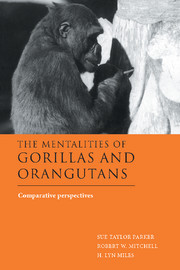Book contents
- Frontmatter
- Contents
- List of contributors
- Preface
- Acknowledgments
- I Comparative evolutionary and developmental perspectives on gorillas and orangutans
- II Cognition and tool use in gorillas and orangutans
- 4 Intelligent tool use in wild Sumatran orangutans
- 5 Orangutans' imitation of tool use: a cognitive interpretation
- 6 Object manipulation and skill organization in the complex food preparation of mountain gorillas
- 7 Development of sensorimotor intelligence in infant gorillas: the manipulation of objects in problem-solving and exploration
- 8 Tool use in captive gorillas
- 9 A survey of tool use in zoo gorillas
- III Communication in gorillas and orangutans
- IV Social cognition in gorillas and orangutans
- V Epilogue
- Index of authors
- Index of subjects
7 - Development of sensorimotor intelligence in infant gorillas: the manipulation of objects in problem-solving and exploration
Published online by Cambridge University Press: 20 October 2009
- Frontmatter
- Contents
- List of contributors
- Preface
- Acknowledgments
- I Comparative evolutionary and developmental perspectives on gorillas and orangutans
- II Cognition and tool use in gorillas and orangutans
- 4 Intelligent tool use in wild Sumatran orangutans
- 5 Orangutans' imitation of tool use: a cognitive interpretation
- 6 Object manipulation and skill organization in the complex food preparation of mountain gorillas
- 7 Development of sensorimotor intelligence in infant gorillas: the manipulation of objects in problem-solving and exploration
- 8 Tool use in captive gorillas
- 9 A survey of tool use in zoo gorillas
- III Communication in gorillas and orangutans
- IV Social cognition in gorillas and orangutans
- V Epilogue
- Index of authors
- Index of subjects
Summary
INTRODUCTION
This chapter is about the development of intelligent manipulations of objects in hand-reared infant gorillas. It is situated within the framework of what Köhler (1921) and Piaget (1936) identified as “practical” or “sensorimotor” intelligence. This kind of intelligence is nonlinguistic and nonreflective. It consists of the ability to produce novel coordinated sequences of actions adapted both to the physical and the social environment. In previous work (Gómez, 1990, 1991), I have explored the practical intelligence of young gorillas in the social domain. In this chapter I will explore their practical intelligence in the physical domain.
In his pioneering work, Köhler (1921) proposed that chimpanzees showed intelligent behavior when confronted with practical problems whose solving involved carrying out physical displacements or manipulations of objects. Chimpanzees were capable of producing actions whose organization was adapted to challenging environmental conditions. For example, when confronted with a goal hanging from the ceiling, the chimpanzees would drag a box under it, or make it fall with a stick, or simply find a roundabout way to approach the goal. Köhler thought that these and other comparable behaviors demonstrated some kind of intelligence or understanding in the apes, different from mere trial-and-error learning à la Thorndike (1898). He suggested that this practical intelligence could be explained within the framework of Gestalt concepts, but he never developed a detailed theoretical account of it.
It was Piaget (1936) who some years later provided a comprehensive theory of practical intelligence. He called it “sensorimotor” intelligence to emphasize the lack of underlying symbolic representations supporting the organization of the actions.
Information
- Type
- Chapter
- Information
- The Mentalities of Gorillas and OrangutansComparative Perspectives, pp. 160 - 178Publisher: Cambridge University PressPrint publication year: 1999
Accessibility standard: Unknown
- 5
- Cited by
